Invocations and showing up with devotion
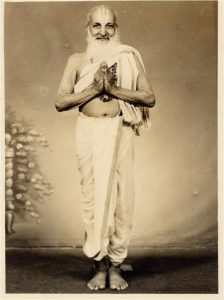
Every morning we begin our practice with a prayer. That prayer consists of three parts
- First is the dedication to Ganesh
- Second is the Yoga prayer or Patanjali Prayer
- Third is the peace chant from the Taittiriya Upanishad often called the student/teacher invocation
Beginning with devotion and determination helps to connect us as one link in a long chain of seekers- and helps us to remember it doesn’t end here. In honoring those who came before and the great tradition that is our support we also honor one another. Let’s look at each dedication…
Ganesha
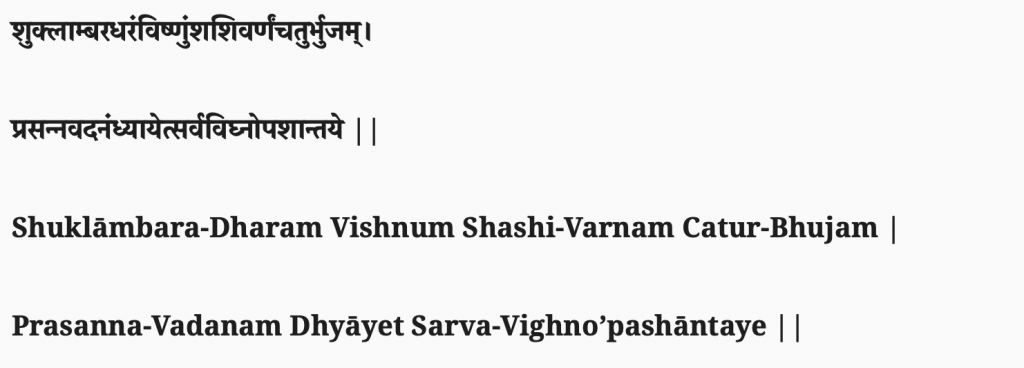
- Shukla: White colored
- Ambara: clothes/sky
- Dhara: wearing
- Vishnu: All Pervading
- Shashin: moon
- Varna: appearance
- Chatur: Four
- Bhujam: Arms
- Prasanna: gracious/kind
- Vadanam: Face
- Dhyaayet: Meditate; (from Dhyan)
- Sarva: All
- Vighna: Troubles
- Upashaantaye: calmed
“We meditate on Ganesha, whose dress is the wide white sky, who is all pervading, who is bright like the moon, whose arms are spread to all four sides
One with the gracious and compassionate face, We meditate on you to calm all troubles”
Traditionally before beginning any ritual (yoga practice is an example) Lord Ganesh or Ganapati is invoked first. In the ritual of sandhya this invocation is used first. Another name for Ganesha is “Vinayak” which means remover of obstacles. More specifically though Ganesh is the ruler of obstacles. So we begin our practice each day with a prayer to remove the obstacles on our path to self realization and to ask that all those that come be for our betterment.
Sometimes I think of obstacles as speed bumps rather than barriers….a means by which to slow down and reassess.
Practicing with Ramaswami you will often here a different Ganesha mantra chanted. It is a prayer chanted in the Tamil language, Sir’s mother tongue. This too is a Ganesha prayer
Aindhu Karathanai Aanai Muhathanai
Indhin Illam Pirai Pondra Eyitranai
Nandhi Magan Thanai Gnana Korhunthinai
Pundhiyil Vaithadi Potruhindrene
you can hear Sir chanting both mantras here
Patanjali
Krishnamacharya believed that the purpose of life was to, as Ramaswami writes, “to study the Sastras, understand the meaning of life, and abide by it”
Again we see here the concept of pramana as agamah (study the texts), anumana (infer the meaning) and pratyaksa (abide in the truth). Studying with his student of 33 years (Ramaswami) has given me a renewed passion and enthusiasm for such inquiry. Patanjali’s yoga sutram is one such text. Although compact it is a clear guide to our aim.
So who was Patanjali? Patanjali was a great Rishi (upoholder of the truth) who wrote texts on yoga, ayurveda and sanskrit grammar for the benefit of humanity. Yoga for the mind, ayurveda for the body and sanskrit grammar for clear speech and communication. These three disciplines (known as tri-karana) are essential for humanity’s well being and peace. We can thank Patanjali for his commitment to the betterment of his fellow humans.
We see this dedication in the yoga sutra invocation:
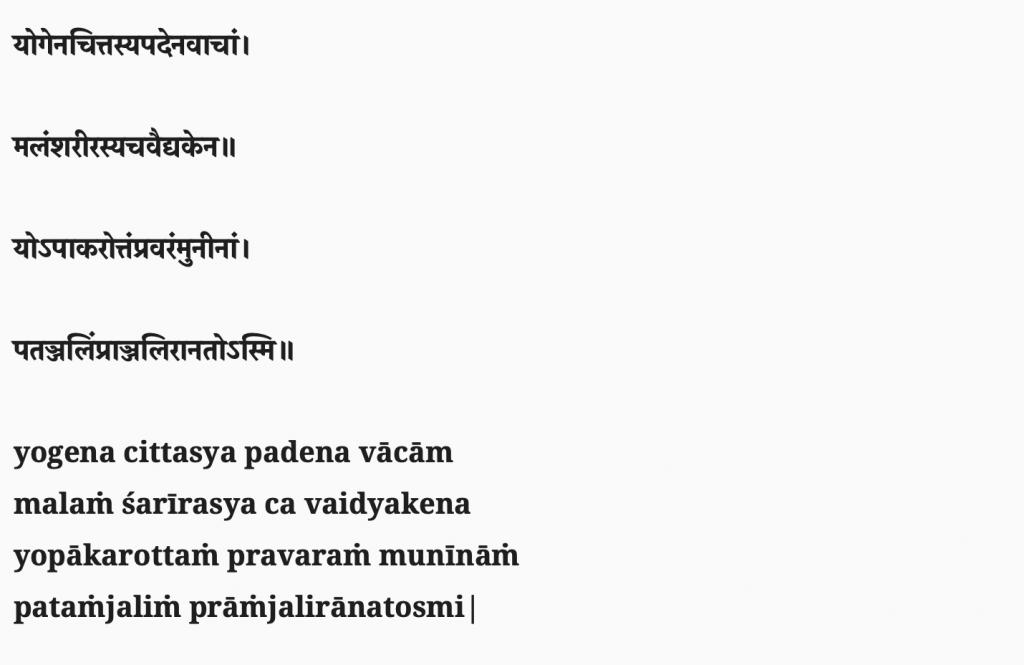
“Through Yoga, of the mind, by grammar, of language [sanskrit]
Through medical science of the body,the drosses, [ayurveda]
The one who eradicated, to Him of the lineage of sages, [yoga]
To Patanjali, I remain offering my salutation”
~translated by Srivatsa Ramaswami
The story goes that Adishesha (Vishnu’s support/seat pictured as a 1000 headed cobra) was commissioned by Lord Shiva to take a human birth and clarify the teachings of the tri-karana beginning with ayurveda in written form. Adishesha then fell (pat) from the sky into the folded prayer hands (anjali) of a father praying for a son. That son was born as Gonika who we now know as Patanjali. He wrote the famous texts on the tri-karana including the yoga sutras we know today. The prayer continues…
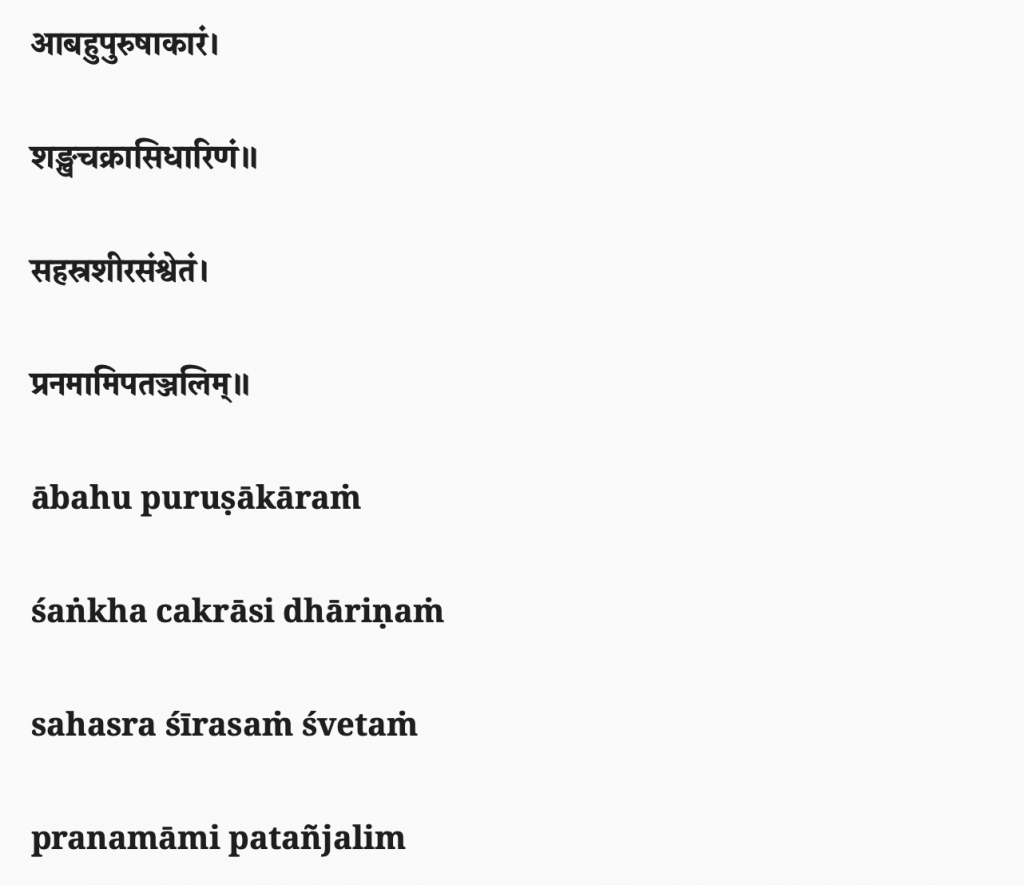
“Spirit rendered into human form
Bearing the conch, the discus and the sword
Adorned with the cobra of one thousand heads—
I bow down before Patañjali.”
~translated by Kofi Busia

to the infinite one, king of the naga, I bow, I bow
I chant this before sadhana but it is also chanted before study of the sutras. It is a good practice bringing us in contact mentally and emotionally with the lineage of yoga. Ramaswami calls this the yoga prayer. It places us in the seat of humility and wonder as we express our deep gratitude and homage to those who cared enough not to stop at their own self realization but to share the gift for the illumination of all.
this section ends with a nod to Krishnamacharya and our lineage of teachers in the words “asmadacharyebhya sarvebhyo namo namah” or to my dear teachers all I bow, we bow. Honoring our teachers brings not only humility but also clarity on how to practice and share the teachings. If we ignore the fact that yoga has been practiced for millennia (long before it became popular globally) then we are continuously trying to integrate what we’ve learned into our current and very limited world scope. This is how yoga practice becomes mere shapes and show. We must be lifelong students and be respectful of the depths.
You can read the story of Patanjali (sometimes called Tapanjali- due to the intense tapas done) HERE or in Sir’s book “Yoga for the Three Stages of Life”
Shanti mantra
Finally the beautiful student/teacher invocation. This invocation is a peace chant coming from the Taittiriya, Katha and Svetashatvara Upanishads
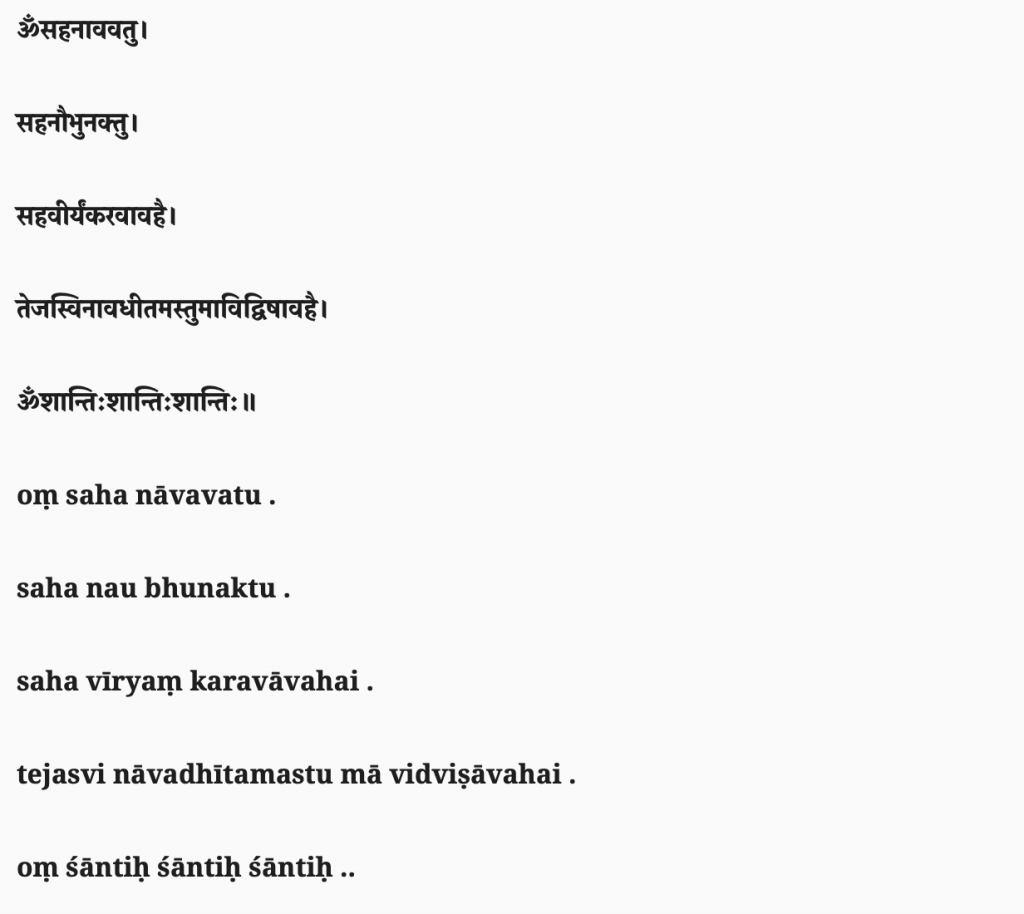
- Om; the pranava mantra. The name of Isvara
- Saha: may isvara
- nau: we two (student and teacher)
- bhunaktu: nourish us
- viryam: enthusiasm and vigour
- karavavahai: working together
- tejasvi: illuminating, filled with tejas (light)
- adhita: what has been studied
- vidvisavahai: may it not be animous/hostile
- Shanti: peace
Om, may we be protected together.
May we be nourished together (with knowledge)
May we remain enthusiastic in our efforts and have what is required to move forward in our studies
Let their be no misunderstanding between us
Let their be freedom from the three afflictions: peace, peace, peace (adhyatmaka, adhibautika, adhidaivika)
This prayer is a connection between the teacher, the student and the eternal. It is as it sounds, a prayer that we set our ego and ignorance aside and open our hearts and minds to the possibility of this practice. As we commit with enthusiasm to our own development we also commit to care for eachother. It is not a one sided prayer. Both teacher and student are asking for grace. The teacher needs good health, stamina, committed students, humility, time for studentship. The students need faith, steadfastness and the ability to remember and apply the teachings. No one is on a pedestal. we are here together. Let us move forward with a prayer for clarity and support.
The three shantis are chanted at the end of Shanti mantras to ask for peace and release from the three obstacles. The obstacles in our own body/mind complex, the obstacles in our relationship with other beings and the obstacles presented by the forces of nature.
So when we stand to begin. hands folded in reverence we begin with a prayer for a clear path, we honor the great ones who’ve come before us and their compassionate efforts to help us all and we gaze upon eachother with kindness, with love in our hearts and with mutual respect.
Thank you for your care. Thank you for doing your best to honor yoga and eachother. Thank you
See you tomorrow,
Jennifer
